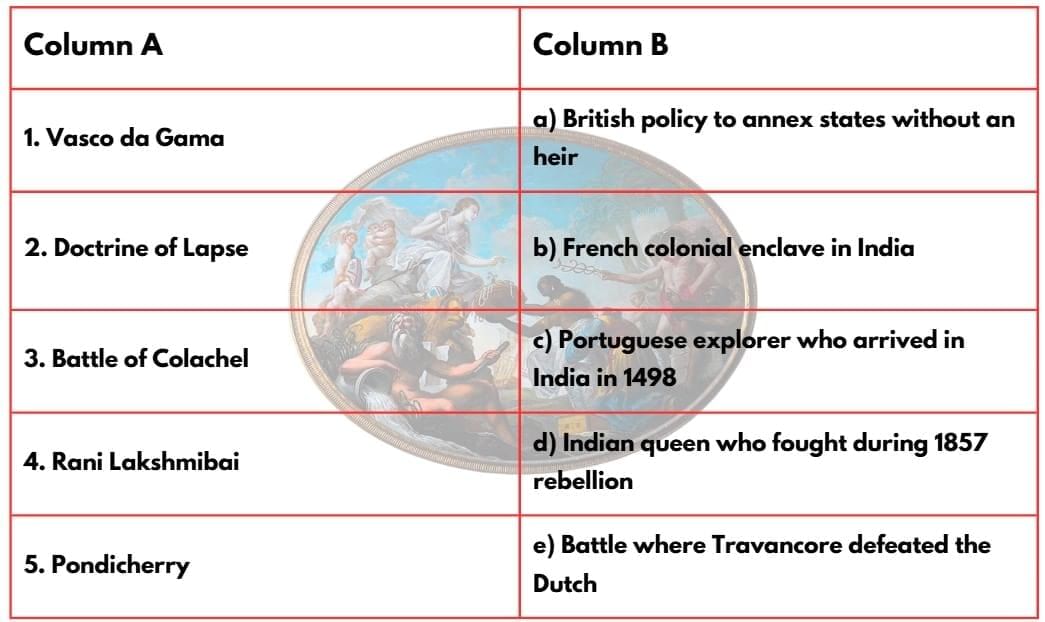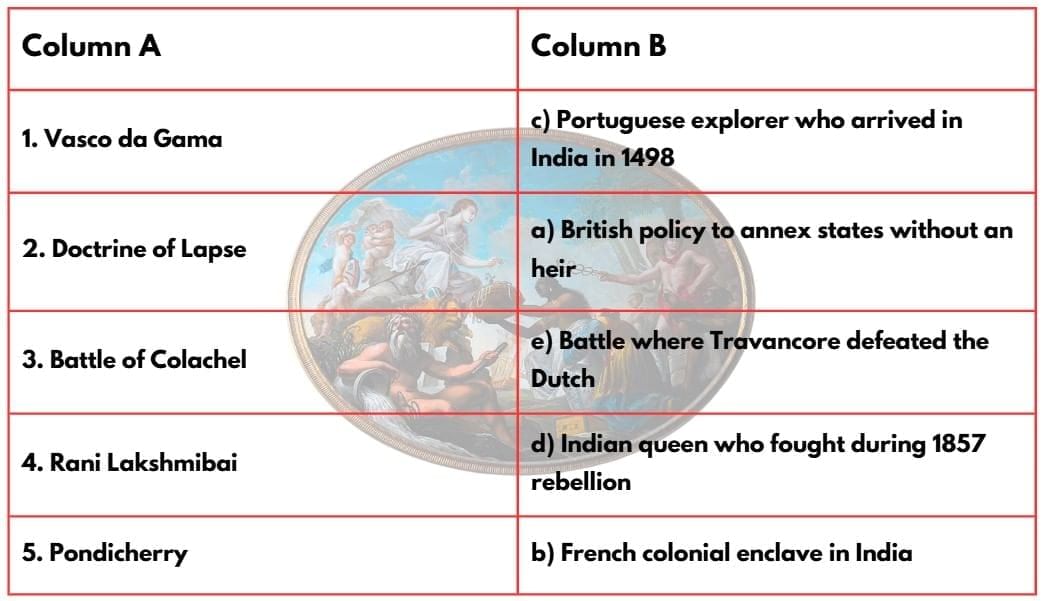Worksheet Solutions: The Colonial Era in India | Worksheets with Solutions for Class 8 PDF Download
| Table of contents |

|
| Multiple Choice Questions (MCQs) |

|
| Match the Following |

|
| True or False |

|
| Fill in the Blanks |

|
| Very Short Answer Questions |

|
Multiple Choice Questions (MCQs)
Q1. What is colonialism?
(a) One country taking control of another, imposing political, economic, and cultural systems
(b) Trading goods between countries
(c) Forming alliances for protection
(d) Promoting local cultures
Ans: (a) One country taking control of another, imposing political, economic, and cultural systems
Colonialism involves domination and control by one country over another region’s political, economic, and cultural systems.
Q2. Which European explorer arrived in India in 1498, marking the start of European colonisation?
(a) Christopher Columbus
(b) Vasco da Gama
(c) Ferdinand Magellan
(d) Robert Clive
Ans: (b) Vasco da Gama
Vasco da Gama’s arrival at Kappad marked the beginning of European colonisation in India.Vasco da Gama
Q3. The Portuguese used which system to control trade in the Arabian Sea?
(a) Subsidiary Alliance
(b) Cartaz pass system
(c) Doctrine of Lapse
(d) Divide and Rule
Ans: (b) Cartaz pass system
The Portuguese required ships to buy passes to trade in the Arabian Sea, controlling maritime commerce.
Q4. Which Indian queen resisted Portuguese control in Ullal using alliances and fireballs made from coconut shells?
(a) Rani Lakshmibai
(b) Rani Abbakka
(c) Begum Hazrat Mahal
(d) Rani Durgavati
Ans: (b) Rani Abbakka
She successfully resisted Portuguese attempts to seize Ullal and was known for bold tactics against them.Rani Abbakka
Q5. The Dutch lost control in India after which battle?
(a) Battle of Plassey
(b) Battle of Colachel
(c) Battle of Buxar
(d) Battle of Panipat
Ans: (b) Battle of Colachel
King Marthanda Varma’s forces defeated the Dutch in this rare Asian victory over Europeans.Battle of Colachel
Q6. Which European power established a trading post in Pondicherry in 1674?
(a) Portuguese
(b) Dutch
(c) French
(d) British
Ans: (c) French
Pondicherry became the French East India Company’s key colony in India.
Q7. What strategy did the British use to become rulers while pretending to be traders?
(a) Subsidiary Alliance
(b) Divide and Rule
(c) Cartaz system
(d) Assimilation policy
Ans: (b) Divide and Rule
British exploited rivalries among Indian rulers, gaining power step-by-step.
Q8. The Doctrine of Lapse allowed the British to annex princely states on what condition?
(a) Ruler died without a natural male heir
(b) Ruler converted to Christianity
(c) Territory was conquered by British army
(d) Ruler was voted out
Ans: (a) Ruler died without a natural male heir
This policy ignored traditional adoption practices to seize territory.
Q9. What was one major cause of the Bengal Famine of 1770–72?
(a) Crop failure only
(b) British taxation demands during famine
(c) War destruction
(d) Natural drought alone
Ans: (b) British taxation demands during famine
High taxes during famine worsened the crisis, causing millions of deaths.
Q10. Which Indian leader wrote about the drain of India’s wealth caused by British rule?
(a) Dadabhai Naoroji
(b) Jawaharlal Nehru
(c) Mahatma Gandhi
(d) Romesh Chunder Dutt
Ans: (a) Dadabhai Naoroji
He highlighted economic exploitation and wealth drain in his writings.Dadabhai Naoroji
Match the Following

Ans:
True or False
Q1. The British used a ‘divide and rule’ policy to control India.
Ans: True
This policy helped widen divisions to strengthen British hold.
Q2. The Portuguese Inquisition in Goa lasted until the early 19th century.
Ans: True
It continued until 1812, persecuting various religious groups.
Q3. The French extensively interfered in Indian social and religious customs.
Ans: False
The French mostly avoided interfering in social and religious life except occasional incidents.
Q4. The Bengal Famine killed around 10 million people due to both crop failure and British policies.
Ans: True
Harsh taxation increased suffering during crop failures.
Q5. The Battle of Plassey was won with the help of Mir Jafar’s betrayal of Nawab Siraj-ud-daulah.
Ans: True
Mir Jafar’s mutiny enabled the British victory.
Q6. The British Crown took over direct control of India from the East India Company after 1857.
Ans: True
The British Raj started post-1857 rebellion.
Fill in the Blanks
Q1. Colonialism began in the __________ century with European expansion.
Ans: Colonialism began in the 15th century with European expansion.
Q2. Vasco da Gama landed at __________ in India.
Ans: Vasco da Gama landed at Kappad (near Kozhikode) in India.
Q3. __________ was the colonial capital of Portuguese India.
Ans: Goa was the colonial capital of Portuguese India.
Q4. The British used the __________ strategy to exploit rivalries among Indian rulers.
Ans: The British used the Divide and Rule strategy to exploit rivalries among Indian rulers.
Q5. The __________ rebellion of 1857 is considered a major turning point in Indian resistance.
Ans: The Great Rebellion of 1857 is considered a major turning point in Indian resistance.
Q6. The __________ rebellion was led by ascetics opposing British tax policies.
Ans: The Sanyasi-Fakir rebellion was led by ascetics opposing British tax policies.
Q7. The British education policy was shaped by Thomas __________.
Ans: The British education policy was shaped by Thomas Macaulay.
Very Short Answer Questions
Q1. What was the main goal of European colonialism?
Ans: To gain wealth, power, and influence by controlling other countries politically, economically, and culturally.
Q2. Name the European powers that competed for control over India.
Ans: Portuguese, Dutch, French, and British.
Q3. Who were Rani Abbakka I and II?
Ans: Queens of Ullal who resisted Portuguese colonial advances in southern Karnataka.
Q4. What was the significance of the Battle of Plassey?
Ans: It enabled the British East India Company to gain control over Bengal and marked the beginning of British political dominance in India.
Q5. Explain the Doctrine of Lapse briefly.
Ans: A British policy allowing annexation of princely states if a ruler died without a natural male heir, ignoring local customs.
Q6. What caused the Bengal Famine of 1770 to become so deadly?
Ans: A combination of crop failure and oppressive British taxation policies during the famine.
Q7. Name one way the British changed traditional Indian industries.
Ans: They imposed heavy taxes on Indian textiles and flooded India with British goods, causing the decline of indigenous industries.
Q8. Who was Begum Hazrat Mahal and what role did she play?
Ans: She led the defence of Lucknow during the 1857 rebellion against British forces and symbolized resistance.
Q9. How did the British education policy divide Indian society?
Ans: By creating an English-educated elite (“Brown Englishmen”) that was culturally separated from the majority who spoke native languages.
Q10. What was one unintended positive consequence of colonial rule in India?
Ans: The opening of India to global cultural exchanges and the translation of Indian texts into European languages, influencing western thought.
FAQs on Worksheet Solutions: The Colonial Era in India - Worksheets with Solutions for Class 8
| 1. What were the main reasons for the British colonization of India? |  |
| 2. How did British rule impact Indian society and culture? |  |
| 3. What were some major policies implemented by the British during their rule in India? |  |
| 4. What role did Indian nationalism play during the colonial era? |  |
| 5. How did the colonial era influence India's economy? |  |















